Table of Contents
ANIMALS AT THE LIBRARY

|
Judy Sierra’s rhyming picture book Wild About Books (Knopf Books for Young Readers, 2004) features librarian Molly McGrew who mistakenly drives the bookmobile into the zoo and soon has all the animals hooked on reading and writing. The book is a riot of clever word play, and there are a lot of charming little touches – the crocodiles end up reading Peter Pan; the giraffes prefer tall books about skyscrapers and redwood trees. The conclusion: there’s something for everybody at the library – and you can even write your own books too. For ages 3-7. |

|
In Toni Buzzeo’s No T. Rex in the Library (Margaret K. McElderry Books, 2010), Tess – who wears great striped stockings – is out of control. “TIME OUT!” her mother shouts. Then Tess, sent to sit next to a library cart, tips over a stack of books, from one of which leaps a rampaging T. rex. A lesson in how not to behave in the library for ages 3-5. |
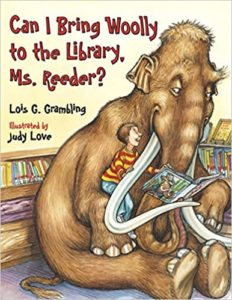
|
Lois Grambling’s Can I Bring Woolly to the Library, Ms. Reeder? (Charlesbridge Publishing, 2012) is an object lesson in library etiquette and procedure as a little boy attempts to bring his woolly mammoth to the library. (No thumping or bellowing.) For ages 4-8. |

|
Marni McGee’s Winston the Book Wolf (Walker Children’s Books, 2006) is a literary take on the tale of Little Red Riding Hood. Winston the Wolf likes nothing better than to eat books – to the point where he’s been banned from the local library for his destructive chewing. Luckily he meets a little girl named Rosie (wearing a red hoodie and carrying a basket) who shows him that it’s better to read books than to eat them. Soon Winston is an avid reader – and Rosie even comes up with a scheme for smuggling him back into the library, disguised in her Grandma’s clothes. Soon the reformed Book Wolf is reading to groups of kids at storytime. For ages 3-7. |

|
If Winston catches your fancy, also check out Oliver Jeffers’s The Incredible Book Eating Boy (Philomel, 2007) in which Henry devours books – that is, he chews them up and eats them, and the more he eats, the smarter he gets. Eventually, however, Henry’s habit brings on a massive case of physical and mental indigestion – and he has to find a better way to interact with books. Wonderful cartoon-style illustrations enhance the story. For ages 4-8. |
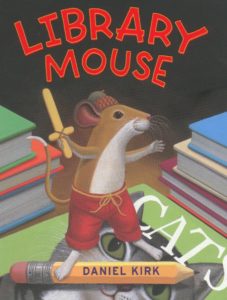
|
In Daniel Kirk’s The Library Mouse (Harry N. Abrams, 2007), Sam – a mouse – lives in a hole in the library behind the children’s reference book section. Every night, after the library is closed, he reads to his heart’s content – and soon he decides to start writing as well. He tucks his first work – Squeak! A Mouse’s Life – into the library’s biography section; then follows up with The Lonely Cheese and The Mystery of Mouse Mansion. The curious librarian invites Sam to a “Meet the Author Day,” which Sam turns into a writing workshop, with participating kids producing their own books. Several sequels. For ages 4-8. |
| The World of Library Mouse is a teaching guide to accompany the Library Mouse books. | |
| Also see Nice Mice and Awesome Rats. | |

|
In Mary Ann Fraser’s I.Q. Goes to the Library (Walker Children’s Books, 2003), I.Q. – a bright and curious little mouse who lives in an elementary-school classroom – accompanies the kids on a trip to the library. The big worry: will I.Q. be able to get a library card? For ages 4-8. |
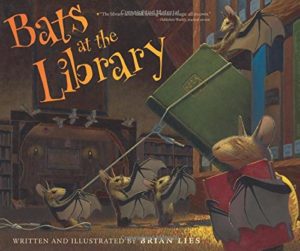
|
In Brian Lies’s Bats at the Library (Houghton Mifflin Books for Children, 2008), a window left open at the library leads to an exciting adventure for a colony of bats, who zoom through the building taking pictures of themselves with the copier, swimming in the fountain, and holding a storytime for young bats featuring such bat favorites as Goodnight Sun and Little Red Riding Bat. For ages 4-8. |
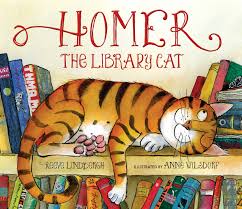
|
In Reeve Lindbergh’s rhyming Homer, the Library Cat (Candlewick, 2011), orange-striped Homer is a quiet cat who leads a peaceful existence with a quiet owner – until one day a tremendous CRASH frightens him into leaping out the window. Finally, after contending with a very noisy world, he finds his owner in another quiet place – she’s the town librarian – and the relieved Homer becomes the library cat. For ages 4-8. |
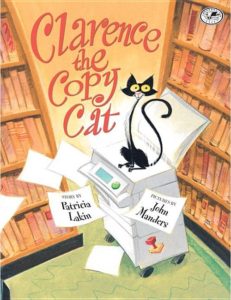
|
In Patricia Lakin’s Clarence the Copy Cat (Dragonfly Books, 2007), pacifist Clarence – booted from Sam’s Sandwich Shop for his refusal to harm mice – finds a happy home in the local library, where he particularly enjoys sitting on top of the copy machine. Then, to Clarence’s horror, a book-chewing mouse moves in. Clarence’s mouse machinations are hilarious and the eventual solution – which involves the copy machine – scares the mouse away once and for all. For ages 4-8. |

|
By Vicki Myron and Bret Witter, Dewey: There’s a Cat in the Library (Little, Brown Books for Young Readers, 2009) is the (true) picture-book story of the little kitten librarian Myron found in the return box at her Iowa public library. Named Dewey Readmore Books, the kitten, nursed back to health, grew up to become the official library cat and won over the entire town. For ages 4-8. |
| Also by Myron and Witter, Dewey the Library Cat (Little, Brown Books for Young Readers, 2010) is a more detailed 200+-page version of the story for ages 9-14. | |
| Also see CATS: History, Science, and Story. | |
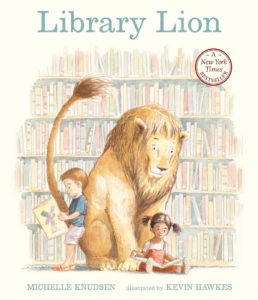
|
In Michelle Knudsen’s Library Lion (Candlewick, 2009), Miss Merriweather, head librarian, allows Lion to stay at the library provided that he breaks no rules – despite the disapproval of uptight circulation assistant Mr. McBee. Lion proves to be a great help – he dusts shelves with his tail, licks envelopes, and serves as a comfy backrest for young readers – but when Miss Merriweather falls and breaks an arm, he summons help with a tremendous ROAR. Upset by his breaking of the rules, Lion vanishes from the library, only to return when it becomes clear how much he is missed. For ages 4-8. |
| From the publisher, see this story hour activity guide to accompany Library Lion. | |

|
Susan G. Larkin’s Top Cats: The Life and Times of the New York Public Library Lions (Pomegranate, 2007) is an 80-page history of Patience and Fortitude, the much-loved marble lions that flank the entrance to the New York Public Library, illustrated with dozens of photographs, cartoons, prints, and drawings. |
| For a short online history of the NYPL lions (with accompanying photo of Patience), visit the library’s website here. |
